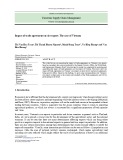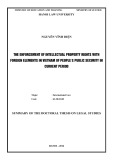
TNU Journal of Science and Technology
230(03): 86 - 94
http://jst.tnu.edu.vn 86 Email: jst@tnu.edu.vn
THE EFFECTS OF INTELLECTUAL PROPERTY RIGHTS – IPRS ON
KOREA’S EXPORT TECHNOLOGY PRODUCTS
Lee Song Kun*
Phenikaa University
ARTICLE INFO
ABSTRACT
Received:
25/12/2024
This study investigates the impact of intellectual property rights
enforcement on Korea’s technological exports to 158 partner countries
during 2010–2022. Using a gravity model and GMM estimation, the
findings reveal a significant positive effect of IPR on exports across all
technology levels. Specifically, a one-unit increase in the IPR index of
importing countries leads to a 0.407% rise in high-tech exports, a 0.157%
increase in medium-tech exports, and a 0.096% increase in low-tech
exports. These results highlight the pivotal role of strong IPR regimes in
promoting Korea’s technological export growth, particularly in innovation-
intensive industries. This underscores the critical role of robust IPR
regimes in protecting innovation, reducing imitation risks, and fostering
trade in innovation-intensive sectors. High-tech industries, which heavily
rely on intellectual property protection to safeguard R&D investments,
benefit the most from stringent intellectual property rights enforcement.
Medium- and low-tech exports also gain from intellectual property rights
by reducing competition from counterfeit or low-quality products and
ensuring a fair market environment. These findings highlight the
importance of engaging with IPR-compliant markets to maximize Korea’s
technological export potential and strengthen its competitive advantage in
global high-tech trade.
Revised:
27/3/2025
Published:
28/3/2025
KEYWORDS
Intellectual property rights
Korea
Technology product export
Gravity model
GMM
TÁC ĐỘNG CỦA QUYỀN SỞ HỮU TRÍ TUỆ – IPRS
ĐẾN SẢN PHẨM CÔNG NGHỆ XUẤT KHẨU CỦA HÀN QUỐC
Lee Song Kun
Trường Đại học Phenikaa
THÔNG TIN BÀI BÁO
TÓM TẮT
Ngày nhận bài:
25/12/2024
Nghiên cứu này điều tra tác động của việc thực thi quyền sở hữu trí tuệ
đối với hoạt động xuất khẩu công nghệ của Hàn Quốc sang 158 quốc
gia đối tác trong giai đoạn 2010–2022. Sử dụng mô hình trọng lực và
ước tính GMM, các phát hiện cho thấy tác động tích cực đáng kể của
IPR đối với xuất khẩu ở các nhóm công nghệ thấp, công nghệ trung
bình và công nghệ cao, với tác động mạnh nhất được quan sát thấy đối
với xuất khẩu công nghệ cao. Điều này nhấn mạnh vai trò quan trọng
của các cơ chế bảo vệ quyền sở hữu trí tuệ mạnh mẽ trong việc bảo vệ
sự đổi mới, giảm rủi ro bắt chước và thúc đẩy thương mại trong các
lĩnh vực đòi hỏi nhiều đổi mới. Các ngành công nghệ cao, vốn phụ
thuộc nhiều vào việc bảo vệ quyền sở hữu trí tuệ để bảo vệ các khoản
đầu tư vào R&D, được hưởng lợi nhiều nhất từ việc thực thi nghiêm
ngặt quyền sở hữu trí tuệ. Xuất khẩu công nghệ trung bình và thấp
cũng thu được lợi ích từ IPR bằng cách giảm sự cạnh tranh từ các sản
phẩm giả mạo hoặc chất lượng thấp và đảm bảo môi trường thị trường
công bằng. Kết quả của nghiên cứu này nhấn mạnh tầm quan trọng của
việc tham gia vào các thị trường tuân thủ IPR để tối đa hóa tiềm năng
xuất khẩu công nghệ của Hàn Quốc và tăng cường lợi thế cạnh tranh
của nước này trong thương mại công nghệ cao toàn cầu.
Ngày hoàn thiện:
27/3/2025
Ngày đăng:
28/3/2025
TỪ KHÓA
Quyền sở hữu trí tuệ
Hàn Quốc
Xuất khẩu hàng công nghệ
Mô hình trọng lực
GMM
DOI: https://doi.org/10.34238/tnu-jst.11767
Email: songkun.lee@phenikaa-uni.edu.vn











